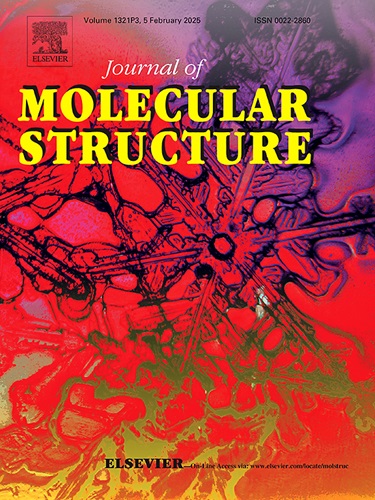冷白光发射镝(III)与哌酸配合物的光致发光研究、judd-手感分析及生物活性
IF 4
2区 化学
Q2 CHEMISTRY, PHYSICAL
引用次数: 0
摘要
以8-乙基-5,8-二氢-5-氧-2-(1-哌嗪基)吡啶(2,3)嘧啶-6-羧酸(也称哌酸)(简称EDOPP)为一级配体,与4种不同的n给体杂环二级配体形成三元配合物,采用液体辅助绿色环保研磨法合成了镝(III)配合物。为了表征这些配合物,采用了几种分析方法。在385 nm激发波长下记录了4F9/2→6H15/2 (482 nm)、4F9/2→6H13/2 (575 nm)和4F9/2→6H11/2 (650 nm)跃迁的光致发光光谱。利用漫反射光谱测定配合物的带隙值(1.9 ~ 2.9 eV)。颜色坐标的计算结果与国际光导委员会(CIE)给出的值一致,证明该发光体位于白光区域。CCT值为3200K,确定复合物为冷白光源。通过PXRD测定了纳米颗粒的粒径(22 ~ 39 nm)。计算出这些配合物的衰减时间为1.26 ~ 1.51 ms。利用近红外区(NIR)记录的光谱吸收数据,利用Judd-Ofelt理论进行详细分析,确定Judd-Ofelt参数(Ω=2,4,6)。还评估了辐射和非辐射跃迁速率以及激光参数。此外,还对这些配合物的抗菌性能进行了评价。这些合成的配合物在各个领域都有广泛的应用,包括传感器、激光器、荧光标记和显示设备。本文章由计算机程序翻译,如有差异,请以英文原文为准。

Photoluminescence studies, judd-ofelt analysis and biological activities of cool white-light emanating dysprosium(III) complexes with pipemidic acid
Synthesis of dysprosium (III) complexes was done using liquid-assisted green and eco-friendly grinding method with 8-Ethyl-5,8-dihydro-5-oxo-2-(1-piperazinyl) pyrido (2,3) pyrimidine-6-carboxylic acid also known as pipemidic acid (here abbreviated as EDOPP) as the primary ligand and four different N-donor heterocyclic secondary ligands to form ternary complexes. To characterize these complexes, several analytical methods were employed. The photoluminescence emission spectra comprised of intense bands for 4F9/2 →6H15/2 (482 nm), 4F9/2 → 6H13/2 (575 nm) and 4F9/2 → 6H11/2 (650 nm) transitions, recorded at 385 nm excitation wavelength. The diffuse reflectance spectra were utilized to determine the band gap values (1.9-2.9 eV) of the complexes. The result for color coordinates are in accordance with the values obtained from Commission Internationale de l'éclairage (CIE), which proves that the emission lies in white light region. CCT values >3200K establish the complexes as cool white light source. Nanoparticle grain size (22-39 nm) was determined through PXRD. Decay time ranging from 1.26 to 1.51 ms were calculated for the complexes. Detailed analysis using Judd-Ofelt theory, which utilized spectral absorption data recorded in the near-infrared region +(NIR), was conducted to ascertain the Judd-Ofelt parameters (Ω=2,4,6). Radiative and non-radiative transition rates, along with lasing parameters, were also assessed. Additionally, the antibacterial and antimicrobial properties of these complexes were evaluated. These synthesized complexes exhibit versatile applications in various sectors, including sensors, lasers, fluorescence labeling, and display devices.
求助全文
通过发布文献求助,成功后即可免费获取论文全文。
去求助
来源期刊

Journal of Molecular Structure
化学-物理化学
CiteScore
7.10
自引率
15.80%
发文量
2384
审稿时长
45 days
期刊介绍:
The Journal of Molecular Structure is dedicated to the publication of full-length articles and review papers, providing important new structural information on all types of chemical species including:
• Stable and unstable molecules in all types of environments (vapour, molecular beam, liquid, solution, liquid crystal, solid state, matrix-isolated, surface-absorbed etc.)
• Chemical intermediates
• Molecules in excited states
• Biological molecules
• Polymers.
The methods used may include any combination of spectroscopic and non-spectroscopic techniques, for example:
• Infrared spectroscopy (mid, far, near)
• Raman spectroscopy and non-linear Raman methods (CARS, etc.)
• Electronic absorption spectroscopy
• Optical rotatory dispersion and circular dichroism
• Fluorescence and phosphorescence techniques
• Electron spectroscopies (PES, XPS), EXAFS, etc.
• Microwave spectroscopy
• Electron diffraction
• NMR and ESR spectroscopies
• Mössbauer spectroscopy
• X-ray crystallography
• Charge Density Analyses
• Computational Studies (supplementing experimental methods)
We encourage publications combining theoretical and experimental approaches. The structural insights gained by the studies should be correlated with the properties, activity and/ or reactivity of the molecule under investigation and the relevance of this molecule and its implications should be discussed.
 求助内容:
求助内容: 应助结果提醒方式:
应助结果提醒方式:


